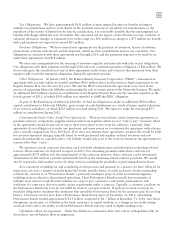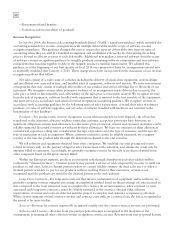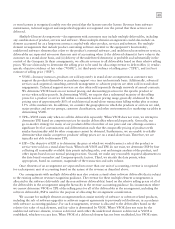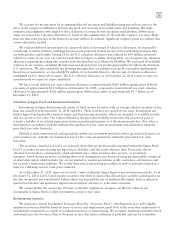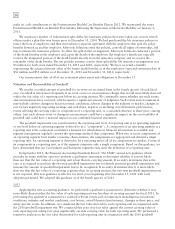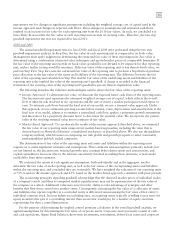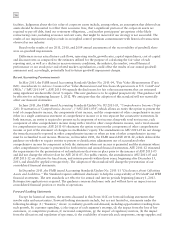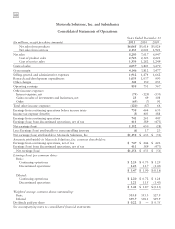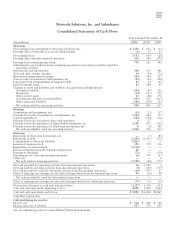Motorola 2011 Annual Report Download - page 61
Download and view the complete annual report
Please find page 61 of the 2011 Motorola annual report below. You can navigate through the pages in the report by either clicking on the pages listed below, or by using the keyword search tool below to find specific information within the annual report.
55
impairment test for changes in significant assumptions including the weighted average cost of capital used in the
income approach and changes in expected cash flows. These changes in assumptions and estimated cash flows
resulted in an increase in fair value for each reporting unit from the 2010 fair values. As such, we concluded it is
more-likely-than-not that the fair value of each reporting unit exceeds its carrying value. Therefore, the two-step
goodwill impairment test was not required for fiscal 2011.
2010 and 2009
The annual goodwill impairment tests for fiscal 2010 and fiscal 2009 were performed using the two step
goodwill impairment analysis. In Step One, the fair value of each reporting unit is compared to its book value.
Management must apply judgment in determining the estimated fair value of these reporting units. Fair value is
determined using a combination of present value techniques and quoted market prices of comparable businesses. If
the fair value of the reporting unit exceeds its book value, goodwill is not deemed to be impaired for that reporting
unit, and no further testing would be necessary. If the fair value of the reporting unit is less than its book value, we
perform Step Two. Step Two uses the calculated fair value of the reporting unit to perform a hypothetical purchase
price allocation to the fair value of the assets and liabilities of the reporting unit. The difference between the fair
value of the reporting unit calculated in Step One and the fair value of the underlying assets and liabilities of the
reporting unit is the implied fair value of the reporting unit’s goodwill. A charge is recorded in the financial
statements if the carrying value of the reporting unit’s goodwill is greater than its implied fair value.
The following describes the valuation methodologies used to derive the fair value of the reporting units:
•Income Approach: To determine fair value, we discount the expected future cash flows of the reporting units.
The discount rate used represents the estimated weighted average cost of capital, which reflects the overall
level of inherent risk involved in our operations and the rate of return a market participant would expect to
earn. To estimate cash flows beyond the final year of our model, we use a terminal value approach. Under
this approach, we use estimated operating income before interest, taxes, depreciation and amortization in the
final year of its model, adjusts it to estimate a normalized cash flow, applies a perpetuity growth assumption
and discounts it by a perpetuity discount factor to determine the terminal value. We incorporate the present
value of the resulting terminal value into its estimate of fair value.
•Market-Based Approach: To corroborate the results of the income approach described above, we estimated
the fair value of our reporting units using several market-based approaches, including the value that is
derived based on Motorola Solutions’ consolidated stock price as described above. We also use the guideline
company method, which focuses on comparing our risk profile and growth prospects to select reasonably
similar/guideline publicly traded companies.
The determination of fair value of the reporting units and assets and liabilities within the reporting units
requires us to make significant estimates and assumptions. These estimates and assumptions primarily include, but
are not limited to, the discount rate, terminal growth rates, earnings before depreciation and amortization, and
capital expenditures forecasts. Due to the inherent uncertainty involved in making these estimates, actual results
could differ from those estimates.
We evaluated the merits of each significant assumption, both individually and in the aggregate, used to
determine the fair value of each reporting unit, as well as the fair values of the corresponding assets and liabilities
within the reporting unit, and concluded they are reasonable. We have weighted the valuation of our reporting units
at 75% based on the income approach and 25% based on the market-based approach, consistent with prior periods.
The accounting principles regarding goodwill acknowledge that the observed market prices of individual trades
of a company’s stock (and thus its computed market capitalization) may not be representative of the fair value of
the company as a whole. Additional value may arise from the ability to take advantage of synergies and other
benefits that flow from control over another entity. Consequently, measuring the fair value of a collection of assets
and liabilities that operate together in a controlled entity is different from measuring the fair value of that entity’s
individual common stock. In most industries, including ours, an acquiring entity typically is willing to pay more for
equity securities that give it a controlling interest than an investor would pay for a number of equity securities
representing less than a controlling interest.
For the purpose of determining the implied control premium calculation in the overall goodwill analysis, we
applied assumptions for determining the fair value of corporate assets. Corporate assets primarily consist of cash
and cash equivalents, Sigma Fund balances, short-term investments, investments, deferred tax assets and corporate


